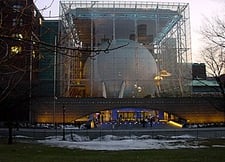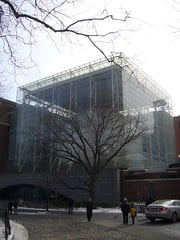Hayden Planetarium: From the Earth to Beyond
Known as both “The Great Sphere” and “The Hayden Sphere,” Hayden Planetarium is a central attraction that is open to the public, drawing countless visitors each and every year. Under the direction of astrophysicist Neil DeGrasse Tyson, this planetarium is housed in The American Natural History Museum in New York. Additionally, it is part of the Rose Center for Space and Earth.
Rich Beginnings
As a part of the American Natural History Museum, it is appropriate to explore the history of the planetarium itself. It has undergone several renovations since its unveiling back in back in 1935. Designed by Trowbridge and Livingston, the Hayden Planetarium was initially made possible by private loans donations that totaled more than $800,000. It was touted as an attraction that would open the eyes of the public to the grand scale and total magnitude of the universe that surrounds us. Over the years it has inspired many and served as a location for many famous films as well, including Woody Allen’s “Manhattan.” The planetarium reached the most recent height of its technological sophistication with the installation of the Zeiss Mark IX projector.
A Complete Experience
In addition to offering visitors a breathtaking look into the depths of the universe, the Hayden Planetarium features exhibits that intrigue and educate as you approach the actual dome for digital projections. These exhibits include scale models of our universe and the cosmic pathway exhibit as well. The cosmic pathway is an exhibit that lays out the known history of the universe to investigative minds. Once inside the planetarium, spectators will experience digital projections that provide access to the entire universe in stunning three-dimensions. Each show takes advantage of technology that allows the images to be virtually taken from real time in the space that actually surrounds our planet. Technology at this level requires the use of a supercomputer designed by Silicon Graphics.
The Hayden Sphere in Action
The planetarium is home to two separate theaters that present different shows and exhibits. In the top half of the dome is the Star Theater where visitors have access shows designed around current astrophysical data that includes a real-time view of the night sky from earth and beyond. In the lower portion of the dome, one can find the Big Bang Theater. Here, a four-minute exhibit depicts the very beginnings of the universe in spectacular detail. Just because the depths of space are probed in the dome it does not mean that the our own planet gets left behind. Just before exiting the planetarium, visitors can visit the Hall of Planet Earth where our natural geography, tectonics, and weather patterns come to life before their very eyes.
Education and Forward Progress
The exhibits that make their home at the Hayden Sphere are focused on both visual wonder and education for people of all ages. As a part of this goal, the planetarium features educational courses on a regular basis in addition to public speakers over the course of each year. These talks include topics such as The Frontier of Astrophysics and the Distinguished Authors Lecture Series. Each program is also regularly updated with the latest scientific advances, the most recent being the renovations that took place after change in the number of planets thought to be within our own universe back in 2000.









